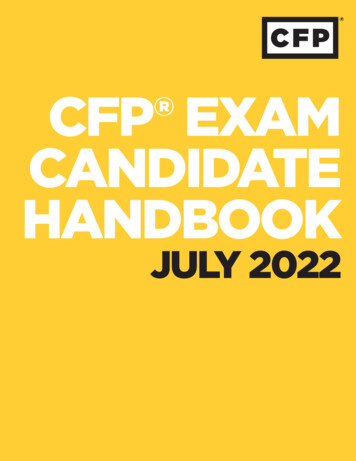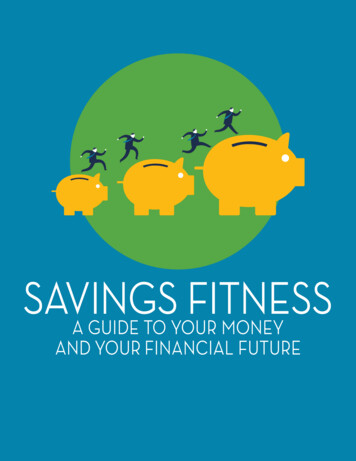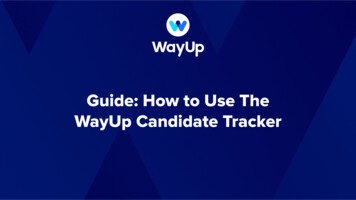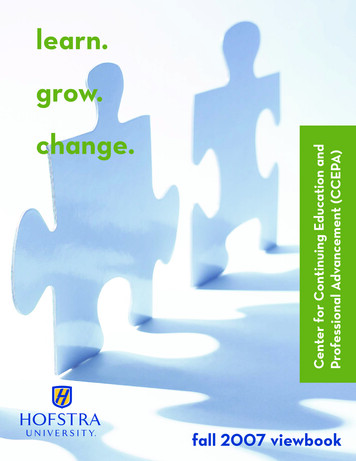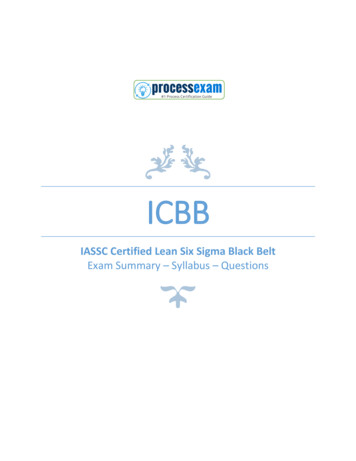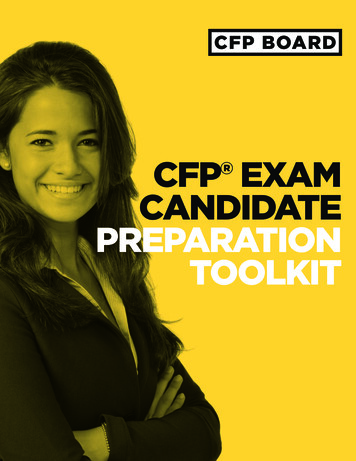
Transcription
CFP EXAMCANDIDATEPREPARATIONTOOLKIT
“Pursuing CFP certification requires a seriousdedication of time and effort. But the rewards it offers arewell worth the effort. CFP Board research has shown that theclients of CFP professionals tend to be more satisfied withtheir financial planning engagements and are more likely torecommend their planner to family or friends.”
This guide is intended to help candidates on thepath to CFP certification gain an understanding ofthe steps it takes to effectively study in preparationfor the CFP Certification Exam.Candidates come to the CFP exam from various paths.Perhaps you are coming directly from completing a degreeor certificate education program, or it’s been a whilesince you focused intensely on studying. You may havebroad experience in financial planning or knowledge moretargeted in specific areas than others. A good exam studystrategy will help you understand your strengths and areasfor development and fill in knowledge gaps. It may alsostrengthen your test taking abilities and endurance.The CFP exam is challenging, but with the right preparationyou can increase your chance of success. And the reward —to add the CFP designation to your credentials — is wellworth the effort.This guide is for candidates who are ready to dedicatethemselves to prepare for the CFP exam. We encourage youto embrace this development opportunity for the personaland career growth that comes from earning CFP certificationand use this Exam Candidate Preparation Toolkit as a guideto applying your best to the task.CFP Board also has the CFP Exam Candidate Handbookavailable, which reviews the process of registering for andtaking the CFP exam. We encourage you to use all of theresources available to help you on your journey to takingthe CFP examination and achieving certification.3
TABLE OF CONTENTSSection 1: Charting your Path to CFP CertificationA Well-Respected Career. . . . . . . . . . . . . . . . . . . . . . . . . . . . . . . . . . . . . . . . . . . . . . . . . . . . . . . . . . . . . . . . . . . . . . . . . . . . . . . . . . . . . . . . . . . . 7Career Growth Prospects. . . . . . . . . . . . . . . . . . . . . . . . . . . . . . . . . . . . . . . . . . . . . . . . . . . . . . . . . . . . . . . . . . . . . . . . . . . . . . . . . . . . . . . . . . . . 8Section 2: Create a Supportive Learning EnvironmentEnlist Employer Support . . . . . . . . . . . . . . . . . . . . . . . . . . . . . . . . . . . . . . . . . . . . . . . . . . . . . . . . . . . . . . . . . . . . . . . . . . . . . . . . . . . . . . . . . . . . 8Find Resources . . . . . . . . . . . . . . . . . . . . . . . . . . . . . . . . . . . . . . . . . . . . . . . . . . . . . . . . . . . . . . . . . . . . . . . . . . . . . . . . . . . . . . . . . . . . . . . . . . . . 10Identify a Mentor. . . . . . . . . . . . . . . . . . . . . . . . . . . . . . . . . . . . . . . . . . . . . . . . . . . . . . . . . . . . . . . . . . . . . . . . . . . . . . . . . . . . . . . . . . . . . . . . . . . 10Seek Peer-to-Peer Support . . . . . . . . . . . . . . . . . . . . . . . . . . . . . . . . . . . . . . . . . . . . . . . . . . . . . . . . . . . . . . . . . . . . . . . . . . . . . . . . . . . . . . . . . 10Manage your Time . . . . . . . . . . . . . . . . . . . . . . . . . . . . . . . . . . . . . . . . . . . . . . . . . . . . . . . . . . . . . . . . . . . . . . . . . . . . . . . . . . . . . . . . . . . . . . . . . . 11Section 3: Develop a Test StrategyExam Structure. . . . . . . . . . . . . . . . . . . . . . . . . . . . . . . . . . . . . . . . . . . . . . . . . . . . . . . . . . . . . . . . . . . . . . . . . . . . . . . . . . . . . . . . . . . . . . . . . . . . 12Learning Preferences and Strengths . . . . . . . . . . . . . . . . . . . . . . . . . . . . . . . . . . . . . . . . . . . . . . . . . . . . . . . . . . . . . . . . . . . . . . . . . . . . . . . . . 13Self-Assessment Tools (Gap Analysis, Practice Exam Strategy). . . . . . . . . . . . . . . . . . . . . . . . . . . . . . . . . . . . . . . . . . . . . . . . . . . . . . . . . 13Test Taker Types and Strategies . . . . . . . . . . . . . . . . . . . . . . . . . . . . . . . . . . . . . . . . . . . . . . . . . . . . . . . . . . . . . . . . . . . . . . . . . . . . . . . . . . . . . 15Exam Day Strategies (Multiple Choice Exams, Exam Day Plan, Test Drive). . . . . . . . . . . . . . . . . . . . . . . . . . . . . . . . . . . . . . . . . . . . . . . 17Right Mindset. . . . . . . . . . . . . . . . . . . . . . . . . . . . . . . . . . . . . . . . . . . . . . . . . . . . . . . . . . . . . . . . . . . . . . . . . . . . . . . . . . . . . . . . . . . . . . . . . . . . . . 19Now It Is Time to Take Action . . . . . . . . . . . . . . . . . . . . . . . . . . . . . . . . . . . . . . . . . . . . . . . . . . . . . . . . . . . . . . . . . . . . . . . . . . . . . . . . . . . . . . . 19AppendixCFP Board Learning Objectives . . . . . . . . . . . . . . . . . . . . . . . . . . . . . . . . . . . . . . . . . . . . . . . . . . . . . . . . . . . . . . . . . . . . . . . . . . . . . . . . . . . . . 215
“CFP certification shows clients that their prospective financialadvisor has a foundation in all types of finances, can solve financialproblems, can devise successful strategies to meet financial goals andwill act as an advisor, counselor and coach.6”
SECTION 1CHARTING YOUR PATHTO CFP CERTIFICATIONYour decision to pursue CFP certification is an important step toward a rewarding career dedicated to helpingpeople bring all the pieces of their financial lives together so they can achieve their life goals. In order to reap thebenefits of personal and career growth that come with achieving certification, you will need to chart your path tobecoming a CFP professional by taking steps that improve your chances of success.Before you dive into exam preparation strategy, consider a few elements that will create a supportiveenvironment for exam preparation.There are four key forces that can serve as a framework to help analyze factors close to you that influence yourwellbeing, and, ultimately, your ability to achieve your certification. Place yourself in a position of strength byevaluating your situation relative to these forces that impact your ability to achieve certification. This frameworkis intended to address emotional, social, vocation al, and educational concerns.MOTIVATIONENVIRONMENTSITUATIONPERFORMANCE Self views/ behavior Organizational supportfor pursuit of certification Social/emotional support Education/training Supportive economiccondition Experience Presence of careerrole models Outcome expectations Knowledge of job market Employer policiessupporting pursuitof certification Access to career options Flexible workrequirements Quality of life associatedwith career In-house developmentactivities within field Physical health Supportive familyinteractions Skills, competencies,and abilities Coping mechanisms Work/life balance Life phase Superior financialrewards HardshipsA WELL-RESPECTED CAREERAn awareness of conditions that impact yourperformance is key to putting an effective plan inplace. Consider all aspects of this framework from yourmotivation to environmental concerns. Make sure youhave the social and emotional support you need fromfriends and family. Be sure to address gaps in yourtraining and work experience. Revisit your motivationfor pursuing certification throughout the process tokeep you on target to achieve your goal.Finding balance across these forces will help you toperform at your peak as you take on the challenge ofearning your certification.First, let’s start with your motivation for pursuingCFP certification. Let’s take a look at the manyreasons certification is worth the effort of successfullycompleting the CFP exam and other requirements.CFP Board believes that the public deserves highquality personal financial planning services deliveredby professionals who have demonstrated the abilityto provide competent and ethical services to clients,and are committed to acting in their best interest.The CFP certification prepares you for a career-longcommitment to meeting the ever-changing needs ofyour clients.7
4 KEY FORCES: MOTIVATION / ENVIRONMENTCAREER GROWTH PROSPECTSWith your CFP certification, you’ll have two distinctadvantages: You’ll have the knowledge and skills to ensure youhave the confidence, competence and credibilityto elevate your practice to the highest level anddistinguish you from other financial planners.Career opportunities in the financial planning field areexpected to grow more than 15% by 2026, accordingto the Labor Department. U.S. News and World Reportranks Financial Advisor as #6 in Best Business Jobsin 2020.Baby boomers are approaching or reaching retirementage, and millions of Generation Xers are raisingfamilies and saving for their later years. Many willrequire professional guidance to successfully confrontan increasingly uncertain economic future. As aCFP professional, you can get personal satisfactionfrom helping your clients plan for their futures whilesimultaneously building your career.Earning your CFP certification requires a commitmentto learning and a solid grounding in financial planning.Those who have become CFP professionals will tellyou that the work is worth the effort. In fact, accordingto a survey of CFP professionals, 91% of respondentsare very satisfied with their career in financial planningand would recommend CFP certification to otherfinancial professionals. Your CFP certification assures clients and potentialclients that you have achieved the respect,recognition and preferred status that come onlyto the top professionals in the field.Now that we’ve established the key benefits ofcertification and why it’s worth the effort, the nextstep is to develop a plan to successfully complete theexam requirement for certification. You will need to putforth considerable effort for long, sustained, periodsof time to sufficiently cover the breadth of the examin your preparation. For more information on the examrequirements, download the CFP Exam CandidateHandbook at CFP.net/ExamHandbook.SECTION 2CREATE A SUPPORTIVELEARNING ENVIRONMENTTake initiativeLet’s continue addressing the forces needed inpreparation for the exam and focus more specificallyon the importance of creating a supportive learningenvironment. Feeling safe, secure, valued, andempowered is critical to fostering a healthy learningenvironment. High-performing education institutionsaim to control what their students experiencewithin the classroom. They know that establishing asupportive learning environment is critical to studentsuccess. As an exam candidate, you will need tocontrol your environment and experiences outside ofthe classroom. Take steps to establish organizationalsupport for your pursuit of certification in the workplace.The following tips can help you to put in place thesupportive learning environment you will need as youprepare for the exam. Clearly communicate your goal to pursueCFP certification. Make sure your employer listens to and understandsyour goals and your plan to achieve certificationthrough classes, training, and mentorship.Seek available company resources Ask about available resources for training. Inquire if your company is willing to financeyour study program, including materials anda review course. Ask for opportunities to develop new skills. Get involved in new financial planning projects.Take the necessary steps to proactively build aculture of learning at your firm. Work with youremployer to set up a win/win scenario that fostersyour professional development without placing anundue burden on your employer.ENLIST EMPLOYER SUPPORTEnlisting support from your employer is key tobalancing work and time commitments. Candidatesfeel that employer flexibility is important to achievingsuccess through certification.8
4 KEY FORCES: ENVIRONMENTFIND RESOURCESCANDIDATE TIPS FOR SUCCESSBe sure to take advantage of all resources that willhelp prepare you for the exam. These can includethe following:“When studying, you can do so many of onestyle of test questions you start to feel likeyou know the answer to the question beforeyou finish reading. I advise looking at multiplepractice exams and buying the Practice Exams toget a different style of question — the questionsare very close to the actual exam questions.”Review coursesMany exam takers find that a review course – thoughnot required – helps them prepare for the CFP exam.CFP Board provides a partial list of available reviewcourses at CFP.net/reviewcourses; others can be foundby searching online. These courses and their providersare not endorsed or recommended by CFP Board.Be assertive Communicate your goal to pursue CFP certificationand demonstrate your interest and passion for thefield.CFP Board Practice ExamCFP Board offers two Practice Exams to helpcandidates study for the CFP exam. The PracticeExams are full-length, featuring 170 questions. Theyprovide immediate scoring and feedback on correctanswers with rationales. One CFP Board Practice examis included FREE with your CFP exam registrationand, upon registration, will be accessible through youronline account. The second CFP Board Practice Examis available for purchase. Learn more about the CFPBoard Practice Exam at CFP.net/practiceexam. Ask your mentor to explain the skills and technicalabilities missing from your repertoire. Set up meeting schedules. Be prepared with a listof topics or questions that address weaknesses.CFP Board Mentor ProgramThe CFP Board Mentor Program connects candidatesfor CFP certification with established CFP professionalvolunteers in a relationship designed to provide freeone-on-one guidance, advice and support. Details areavailable at CFP.net/Mentor.IDENTIFY A MENTORMentors can help you focus on time management,study strategy, staying motivated, dealing with work/life balance and more. By connecting with a mentor,you can gain valuable insights from your mentor’s ownexperience preparing for and passing the CFP exam.SEEK PEER-TO-PEER SUPPORTIt takes courage and commitment to pursuecertification, but don’t embark on your pursuit alone.Seek out friends, colleagues and other candidateswho will face the same challenges you will encounter.Build your network and use the support group tohelp you overcome obstacles related to work, timecommitments, and gaps in learning.Determine your needs Consider what you hope to gain from a relationshipwith a mentor. Know what you want to obtain before you begin theprocess of identifying your mentor.Candidate ForumCFP Board’s Candidate Forum is an online communityfor those pursuing CFP certification. Candidates canconnect with their peers as they prepare for the CFP exam to find advice and support, share resources andform study groups. You can also connect with otherspreparing for the upcoming exam in the Study GroupForum. The forum is accessible at: candidateforum.CFP.net.Make full use of available tools, advice, and resources.Take the initiative and start conversations. Collaboratewith your peers. You can work as a team to designstrategies that will foster success as you study anddevelop a plan of attack for exam day.Consider their qualities Select someone with more experience, who passedthe exam, and who traversed a similar path to theone you are pursuing. Identify an individual with whom you can speakcandidly about career and workplace issues.CANDIDATE TIPS FOR SUCCESS“I’ve been thankful for the questions and answersmembers posted on the Candidate Forumduring the time I was studying for CFP exam.I owed the success of passing the exam to theexperience and encouragement shared by theforum members.”10
4 KEY FORCES: SITUATIONMANAGE YOUR TIMEPursuit of the CFP certificationrequires candidates to balancecoursework requirements, studyingand day-to-day work responsibilities.And who has the time? Factor inpersonal and family commitmentsand the challenge begins to bevery overwhelming. Facing theseobstacles, priorities must be set inorder for you to achieve your goals.Time spentKnowing exactly how you spendyour time can shed some light onactivities that add little to yourbottom line. Similar to working withclients to track spending, trackingyour daily activities will help youassess how effective you are inbudgeting your time and where youcan carve out some extra study time.TrackingWrite down everything thatyou do in a daily record.Yes, everything!AnalyzeAnalyze the information youcollected throughout your day.Pick five of your biggest timewasters and add up the time.RecordDo you know where your timeis actually going each day? Ifnot, then it’s time to start payingattention. Tracking your time is thebest way to get control of yourtime. Follow the steps below toeliminate time wasters and refocuson your priorities.PlanningMake an upfront investment to drafta plan that creates more time foryourself. Use your planning periodto set your priorities so you can freeup more time throughout your day.Engage your familyMeet with your family to ask: What works well? What doesn’t work well? What will we work on in theweek ahead to improve?Refine your approach Develop a long-term plan thatoutlines mission critical activitiesand objectives that must occurto achieve your goals. Periodically list and reiterateyour goals in order of priority. Spend half of your time workingon two key priorities.7 AM2 PM8 AM3 PM9 AM4 PM10 AM5 PM11 AM6 PM12 PM7 PM1 PM8 PMTime WastersTime Spent12345AdjustGet your time back. List yourpriorities and rank them inorder of importance. Focus 50%of your time on your top twopriorities.Set your course Spend time on what isimportant. Zero in on what is critical andput trivial things aside. Revisit your goals to get a senseof what will help or hinder youraccomplishments. Eliminate roadblocks. Create focus.Priorities1234511
CANDIDATE TIPS FOR SUCCESS“As you get close to the exam, focus onpractice problems rather than trying tolearn everything. Learning everythingthat could be on the exam is futile.”SECTION 3DEVELOP A TEST STRATEGYEXAM STRUCTUREBlueprintBe strategic in your approach to studying the MajorPrincipal Topic areas.A clear understanding of how the exam is structuredwill help you develop an approach for managing thetime you spend preparing for the exam and the timeyou spend responding to the test questions duringthe exam. Take note of the following considerations asyou study for the exam. Emphasize key areas in yourstudies to match the content coverage of the exam. The exam consists of 170 test questions.51% of the exam is covered equally by the followingtopic areas: General Principles of Financial Planning 17% Investment Planning 17% Retirement Savings and Income Planning 17% The test questions are administered in two 3-hoursections separated by a 40-minute break. Each3-hour section is broken into two subsections,with the option for a short break between each.Focus your study to adequately cover the content inheavily-weighted areas. Each section contains 85 questions.36% of the exam covers the following areas: Risk Management and Insurance Planning 12% Test questions are administered at random. Tax Planning 12% Questions are not grouped by topic. Estate Planning 12% All questions are multiple choice.For moderately-weighted topics, ensure your effort ismanaged accordingly.CANDIDATE TIPS FOR SUCCESS“When you are doing a final review of topics,focus less on the individual numbers and facts,and ask yourself “Can I explain this concept;do I understand it fully?””12
4 KEY FORCES: PERFORMANCE13% of the exam will cover the following areas: Professional Conduct and Regulation 7%For the Kinesthetic Learner Put financial planning principles into practice. Education Planning 6% Use scenarios and user stories in the context ofthe contextual variables and the student centeredlearning objectives.Content with the least amount of weight accountsfor 22 items out of 170 total questions on the exam.Be familiar with these areas and don’t neglect themin your study, although they are less critical in termsof content coverage. Actively draft recommendations and financial plansto address various circumstances. Take notes as you read texts.LEARNING PREFERENCES AND STRENGTHS Create note cards, question cards and problem cards.Understand your learning style and evaluate yourstrengths. Develop an approach to studying thatplays to your strengths. Before purchasing resources,research exam prep provider offerings to see if theirprogram aligns with your learning style. Make up self-tests in the same format of the actualtest and take them.For the Visual Learner Use images, maps, and graphic organizers toaccess and understand new information. Gap Analysis. Participate in study groups and review sessions.SELF-ASSESSMENT TOOLS Practice Exam Strategy.A self-assessment allows you to make the most of yourstudy time by showing you where potential gaps inlearning exist. A self-assessment not only focuses onpotential gaps in learning relative to financial planning,it can also afford you a mechanism for mediating andself-regulating your study efforts.Mediating role of self-evaluation: Offers a tool for guiding self-improvementby comparing one’s performance with expertperformance. Outline information. Create charts. Create study sheets. Develop self-test questions. Create visual images to connect theinformation to acronyms.For the Learner with a StrongPreference for Reading and Writing Take significant amounts of notes. Self-evaluation helps candidates organize learning inwork-based contexts. Revisit materials and abstract content throughwriting essays.Gap AnalysisUnderstanding exactly what you know relative tothe exam blueprint helps you to self-regulate yourlearning effort.How do you measure your knowledge relative tothe content addressed by the exam? CFP Boardput together a set of Student-Centered LearningObjectives that provide specific statements thatreflect the expected abilities students should possessonce the course is completed. The Student-CenteredLearning Objectives take the guesswork out ofidentifying potential gaps in acquired knowledge.For the Auditory Learner Listen during lectures and interact in discussions tounderstand new content. Participate in a study group to enhance learningthrough interactions with your peers. Read passages out loud. Recite the main points of each text section. Explain information out loud. Discuss study material with a partner orstudy group. Record lectures and play them during dailycommutes or while doing household chores. Teach the material to someone else.13
4 KEY FORCES: PERFORMANCEYou might want to start with the Student-CenteredLearning Objectives document provided in the appendix.1. Review the learning objectives outlined in theStudent-Centered Learning Objectives.2. Evaluate your own abilities relative to the learningobjectives.3. Reflect on your understanding and rate yourperceived ability relative to the learning objectives.4. When applying the rating, use a simple 4-levelscale that rates your performance from belowperformance standard to exceeds performancestandards.Level 1Level 2Level 3Level 4Below performance standardLimited achievement ofperformance standardCompetentExceeds performancestandardRoutine tasksRoutine and mid-complexitytasksRoutine and complexStrategically importantThis table provides an example of the rating scales applied to Life Insurance learning objectives.Life Insurance (individual)L1L2L3L4a. Explain the underwriting factors commonly used in the life underwritingprocess.b. Differentiate between term, whole life, variable, universal and VUL policiesand select the most appropriate type of coverage to match a client’s specificcircumstances.c. Calculate a client’s insurance needs using alternative approaches, includingthe capital needs, human value, capital retention, income retention and incomemultiplier methods.d. Recommend whether a policy should be replaced based upon quantitative andqualitative factors.e. Describe common life insurance termination options.f. Recommend life insurance purchase and benefits distribution options basedupon needs, financial resources, and cost.The Student-Centered Learning Objectives can be usedas a framework for your Gap Analysis.Once you complete the Gap Analysis, take a momentto formally reflect on what you have learned from thisexercise. The rating scales you applied to your learningprovide descriptions of performance levels andcriteria for success. As you study, use these tools to monitor andevaluate your progress toward mastering financialplanning concepts.14 Identify what you need to do to close the Gap. Describe what you will be able to do when the Gapis ngtargetsEvaluateprogress
4 KEY FORCES: PERFORMANCEPractice Exam StrategyAs you study, be aware of potential errors in yourjudgment. At times, we feel that we have masteredcertain subjects. However, an error in judgment canresult in an illusion that we are strong in subjects thatat the moment seem very easy to remember. Becausethese areas seem very easy, we make the mistake ofunderestimating our ability to forget.To overcome this issue, it is recommended thatcandidates be practical in their approach to studyinginstead of being led by emotion. Use the following tipsto overcome the false belief that you have achievedmastery over the material.More Strategies When you encounter difficult passages in the material,after reading over the material several times, put thetext book down and try to explain to someone whatthe passage says. Verbalizing the material is morepowerful than going through the motions of readinga passage that does not make sense. If no one is around, write down what youunderstand the material from memory. Developan outline and record your knowledge, aiming forsuccinct, coherent and clear descriptions of thematerial you just learned. Discussing what you know with your colleagues willhelp you to identify what you do not know.While taking practice exams draw the followingdiagram for each question.ConfusedMaybe Study like you are preparing for a marathon.Marathon runners do not train by running 24 hours aday. Instead they take regular breaks to ensure theyhave recovered from their training efforts.For SureExcessive studying may actually be counter-productive.Take a more strategic approach and incorporatespaced interval repetition to space out your studyeffort. Introducing time intervals between studysessions is a powerful technique that will improve yourrecall and allow you to spend fewer hours studying. Besure to develop a study routine that allows for you totake free time throughout the week between sessions.Use the scale to record an “X” beside your perceivedability level relative to the content addressed in thequestion. Once you complete the practice test exercise,evaluate your perceived ability relative to yoursuccess in answering the question correctly.TEST TAKER TYPES AND STRATEGIESWe collected some test-taking personality types andhave assembled a few strategies to address typicalshort comings.Read through the personality descriptions to see ifyou recognize any of the traits. If you find that thedescription fits, follow some of our suggestions. Any gaps between your perception and outcomewill need to be addressed to avoid the illusion ofbeing fluent in the area of competency when morestudy is needed.Do you hurry through the exam? Desperately rushes through exam items to ensureyou finish before forgetting what you have learnedCANDIDATE TIPS FOR SUCCESS Anxious before the exam, obsessively repeating bitsof information resulting in confusion“Continue to put yourself in the discomfort of thetestbank and mock exams. You may be temptedto stick in your comfort zone, of reviewingmodule materials and flashcards, but the mocktests are the closest replica of what you canexpect on exam day.” Finishes before the majority of the test takers arehalfway through the first sectionSuggestions: Work on relaxation and managing your stress. Develop a plan of study that avoids crammingby providing ample time for review. Work on test taking strategies during yourreview process.15
4 KEY FORCES: PERFORMANCEOTHER PERSONALITY TYPESDo you have trouble completing tests on time? Moves methodically, answering each test questionslowly and deliberatelyOver confident Typically older and more mature Last to finish Life experiences inform knowledge and insight Tendency to score better on the first section thanthe last Makes mistakes through judgment colored bypersonal beliefs and experiences by failing toaccount for expected norms and standardsSuggestions: Take practice exams.Suggestions: Apply broad principles and standards to justifydecisions made in testing. Practice reading and answering items to increaseyour speed in responding to prompts. Monitor your time throughout the exam. Be aware of the total number of questions on theexam and the time allotted for each section. Recognize when you are making mentalconnections between your personal experiencesand scenarios you encounter on the exam. Scan questions and address more timeconsuming questions later. Use professional standards to guide your decisionmaking in testing situations.Are you a second guesser? Continuously changing answers that seem wrongOveranalyzer Attempts the exam from the perspective of“correcting” flawed content Doubtful of your ability to master the topic Drawn to the complexity of the situation Overanalyze the scenario and make the mistakeof reading into the questionSuggestions: Unless you can clearly state why the answer iswrong, avoid erasing or changing answers. Make incorrect assumptions about the intent ofthe question Bring in additional information instead of readingitems as they are Progress through the test carefully andmethodi
and career growth that comes from earning CFP certification and use this . Exam Candidate Preparation Toolkit. as a guide to applying your best to the task. CFP Board also has the . CFP Exam Candidate Handbook. available, which reviews the process of registering for and taking the
